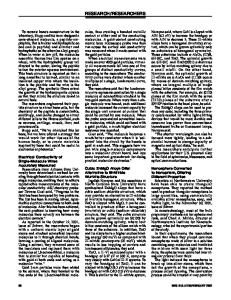Electronic Structure of a Nitrogen Vacancy in Cubic Gallium Nitride
- PDF / 435,504 Bytes
- 6 Pages / 414.72 x 648 pts Page_size
- 62 Downloads / 370 Views
vacancy properties, we first test the methods for the case of stoichiometric c-GaN. Both methods are based on the local density approximation (LDA), and we have used the Ceperley-Alder [7] and Hedin-Lundqvist form [8] of the exchange-correlation potential in the PWPP and TB-LMTO methods, respectively. The crystal lattice parameter, a, which is 4.49A found in epitaxially grown c-GaN [9] has been used in our calculations. The atomic sphere radii in the TB-LMTO method were 2.383 and 1.907A for Ga and N atoms, respectively. Two empty spheres per unit cell, placed at the standard positions, were also used in the TB-LMTO calculations. A new feature in the PWPP method is the use of a 'soft' gallium pseudopotential. The energy cutoff for the plane-wave expansion is 160Ry. The band structure obtained is practically indistinguishable from our previous results [10]. In both methods, Ga 3d states have been treated as valence states. The band structures of c-GaN calculated by the two methods are in excellent agreement for the valence and lower portion of the conduction bands [11]. The differences occur only in the high energy region of the conduction bands. The valence bands split into two parts separated by a gap. From the partial density of states (not shown), the upper part of the valence bands consists predominantly of N2p states hybridized with Ga4p states. The hybridization of N2p and Ga4s states occurs near the 509 Mat. Res. Soc. Symp. Proc. Vol. 395 0 1996 Materials Research Society
bottom of this upper part. In agreement with previously studies [10] , the Ga3d states are significantly mixed with the N2s states and make significant contributions to the cohesive energy of the crystal. Both the Ga4s and N2p states contribute to the formation of the states near the conduction band edge. The calculations were based on the LDA. Neither the self-interaction correction nor the quasi-particle approach to improve the gap were used. The calculated direct energy gaps are 1.82 and 1.92eV for the PWPP and TB-LMTO calculations, respectively. The experimental value of the gap is 3.2eV. The lattice constants determined by the minimization of the total energy are 4.46 and 4.50A and the bulk moduli are 202 and 212Mbar for the PWPP and TB-LMTO methods, respectively. The bulk modulus estimated from experiments is 195-245Mbar. A NITROGEN VACANCY IN c-GaN: STRUCTURAL RELAXATION The lattice relaxation around a N vacancy site in c-GaN was investigated by the PWPP method. To model an isolated N vacancy, we began by removing one nitrogen atom from an ideal 32-atom supercell of GaN with the symmorphic space group having the point group Td. The initial geometry was then relaxed maintaining the symmetry group and calculating self-consistent forces acting on all the atoms in a unit cell. The relaxation energy was found to be 0.04 eV/N-atom vacancy, which is slightly more than 0.03eV/N-atom vacancy found in Ref. 12. The relaxation of the nearest neighbor Ga atoms appears to be small. These atoms relax inward by 0.069 a.u., while the next nearest ne
Data Loading...








